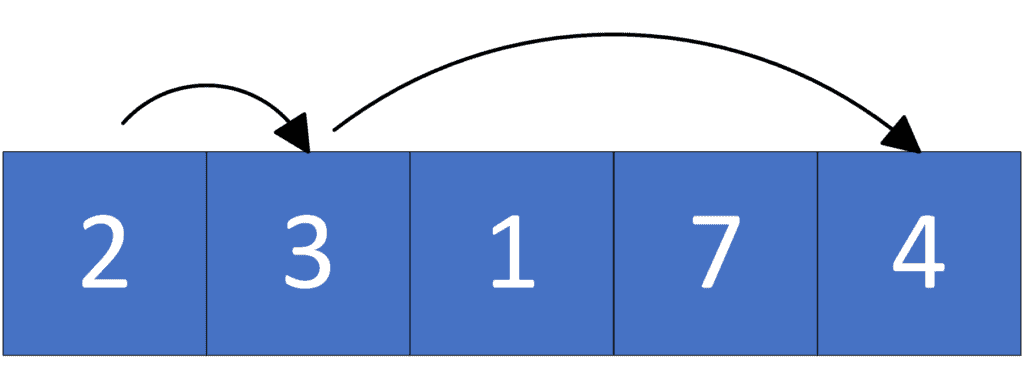1. 概述
在本教程中,我们将探讨如何从数组的起始位置出发,计算到达数组末尾所需的最小跳跃次数。我们将介绍三种不同的解决方案:朴素递归法、动态规划法和贪心算法。每种方法都有其适用场景和复杂度特点,最终我们会选择最优解。
2. 问题定义
给定一个由正整数组成的数组 A,其中每个元素表示从当前位置可以向右跳跃的最大步数。我们的目标是:从数组的第一个元素出发,计算到达数组末尾之后位置所需的最少跳跃次数。
来看一个示例:

以下是一些可能的跳跃路径:
- 2 → 1 → 7 → end
- 2 → 3 → 7 → end
- 2 → 3 → end

观察可知,最优路径是 2 → 3 → 4,跳跃次数为 2 次。
3. 朴素递归法(Brute Force)
3.1. 核心思想
尝试所有可能的跳跃路径,从中找出跳跃次数最少的一条路径。这是最直接的思路,但效率非常低。
3.2. 算法实现
int MinimumJumps(int[] A, int index) {
if (index >= A.length - 1) {
return 0;
}
int minJumps = Integer.MAX_VALUE;
for (int i = 1; i <= A[index]; i++) {
int nextJumps = MinimumJumps(A, index + i);
if (nextJumps != Integer.MAX_VALUE) {
minJumps = Math.min(minJumps, nextJumps + 1);
}
}
return minJumps;
}
- 递归终止条件:当索引超过或等于数组长度时,说明已经到达终点,返回 0。
- 递归逻辑:从当前位置尝试所有可能的跳跃步数,递归计算后续路径的跳跃次数,并取最小值。
3.3. 复杂度分析
- 时间复杂度:最坏情况下为
O(M^N)N是数组长度,M是数组中最大跳跃值。- 每个位置最多有
M种跳跃选择,递归树深度为N。
- 空间复杂度:
O(1)(不考虑递归栈)
⚠️ 踩坑提醒:该方法在大数组时会严重超时,不适用于实际场景。
4. 动态规划法(Dynamic Programming)
4.1. 核心思想
使用动态规划来优化递归方法。我们定义 dp[i] 表示从位置 i 到达终点所需的最小跳跃次数。从后往前填充 dp 数组,利用已知的子问题解来求当前解。
4.2. 算法实现
int MinimumJumps(int[] A) {
int n = A.length;
int[] dp = new int[n];
Arrays.fill(dp, Integer.MAX_VALUE);
dp[n - 1] = 0; // 最后一个位置不需要跳跃
for (int i = n - 2; i >= 0; i--) {
int furthest = Math.min(i + A[i], n - 1);
for (int j = i + 1; j <= furthest; j++) {
if (dp[j] != Integer.MAX_VALUE) {
dp[i] = Math.min(dp[i], dp[j] + 1);
}
}
}
return dp[0];
}
- 初始化:最后一个位置跳跃次数为 0。
- 状态转移:
dp[i] = min(dp[i + 1], dp[i + 2], ..., dp[i + A[i]]) + 1
4.3. 复杂度分析
- 时间复杂度:
O(N * M)- 每个位置最多尝试
M次跳跃。
- 每个位置最多尝试
- 空间复杂度:
O(N)- 使用一个长度为
N的数组存储中间结果。
- 使用一个长度为
✅ 优点:相比递归法,大大减少了重复计算。
⚠️ 踩坑提醒:当跳跃步数较大时,该方法仍有性能瓶颈。
5. 贪心算法(Greedy)
5.1. 核心思想
使用贪心策略,每次尽可能跳得更远。维护当前能到达的最远位置和剩余跳跃步数,一旦当前步数用完,就进行一次跳跃并更新可用步数。
5.2. 算法实现
int MinimumJumps(int[] A) {
if (A.length <= 1) return 0;
int maxReach = A[0];
int steps = A[0];
int jumps = 1;
for (int i = 1; i < A.length; i++) {
maxReach = Math.max(maxReach, i + A[i]);
steps--;
if (steps == 0) {
jumps++;
steps = maxReach - i;
}
}
return jumps;
}
- maxReach:当前能跳到的最远位置。
- steps:当前跳跃剩余步数。
- jumps:已跳跃次数。
5.3. 复杂度分析
- 时间复杂度:
O(N)- 只需遍历一次数组。
- 空间复杂度:
O(1)- 只使用了常数级变量。
✅ 优点:时间复杂度最低,适用于大规模数组。
✅ 推荐使用:在大多数实际场景中,这是最优解。
6. 总结
我们介绍了三种解决“到达数组末尾所需最小跳跃次数”的方法:
| 方法 | 时间复杂度 | 空间复杂度 | 是否推荐 |
|---|---|---|---|
| 递归法 | O(M^N) | O(1) | ❌ |
| 动态规划 | O(N * M) | O(N) | ✅ |
| 贪心算法 | O(N) | O(1) | ✅✅✅ |
最终推荐使用 贪心算法,它在时间效率和空间占用上都达到了最优水平,是解决此类问题的首选方案。